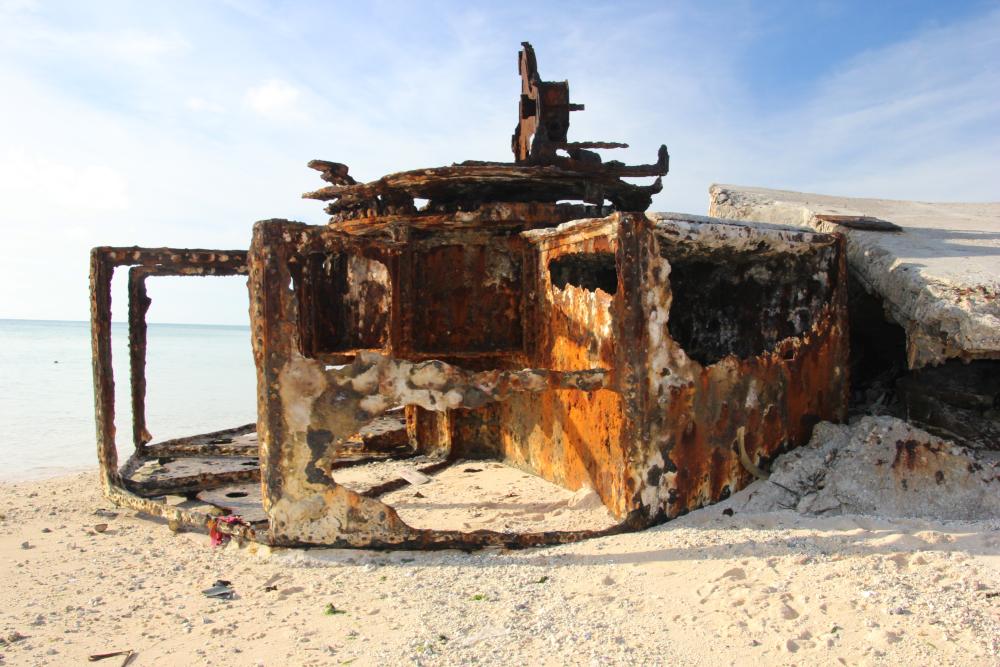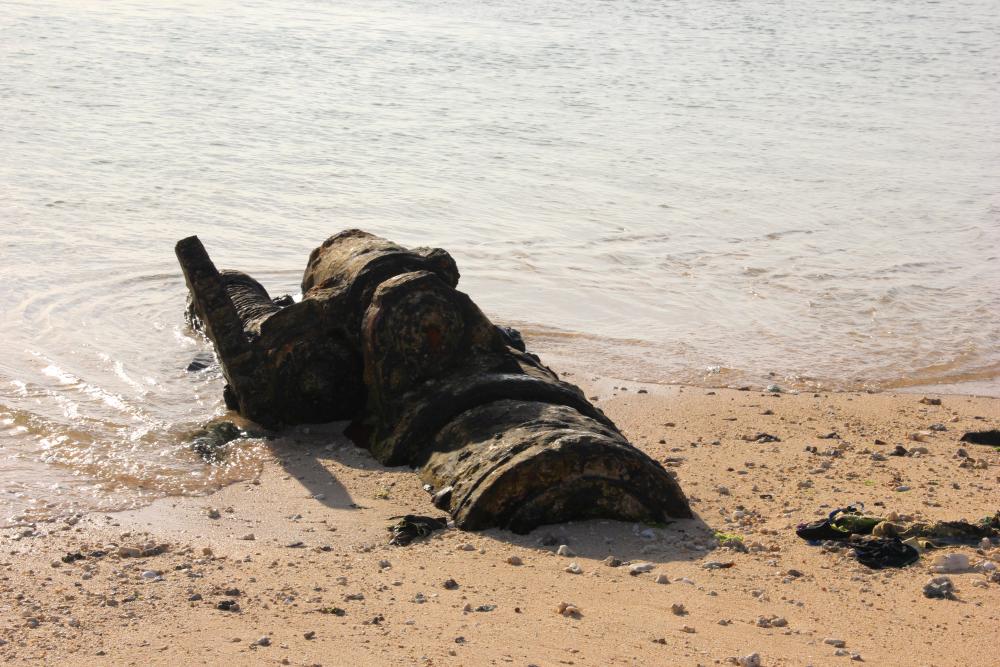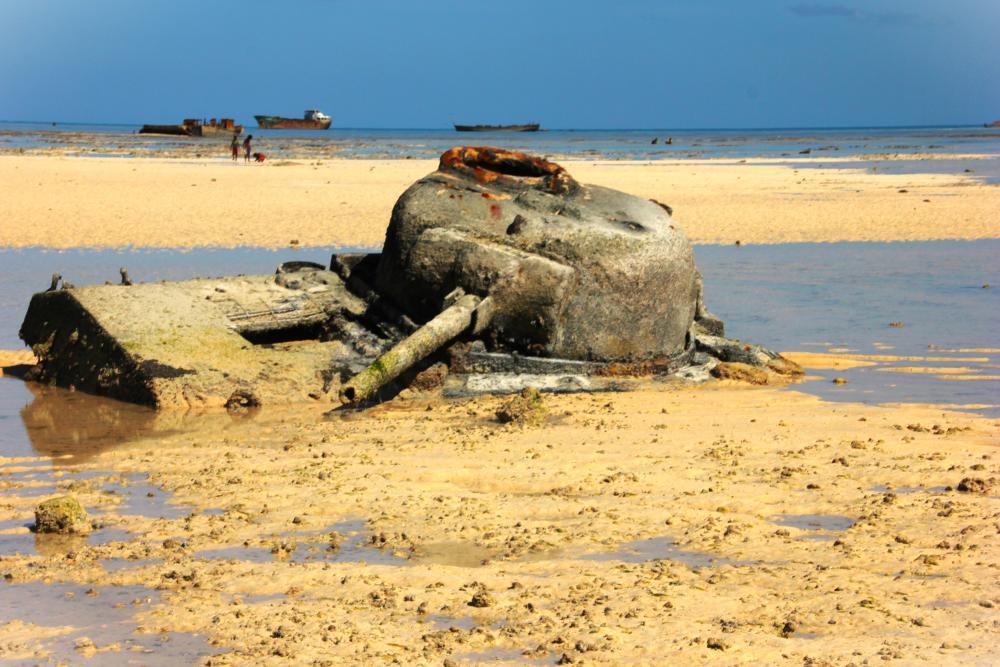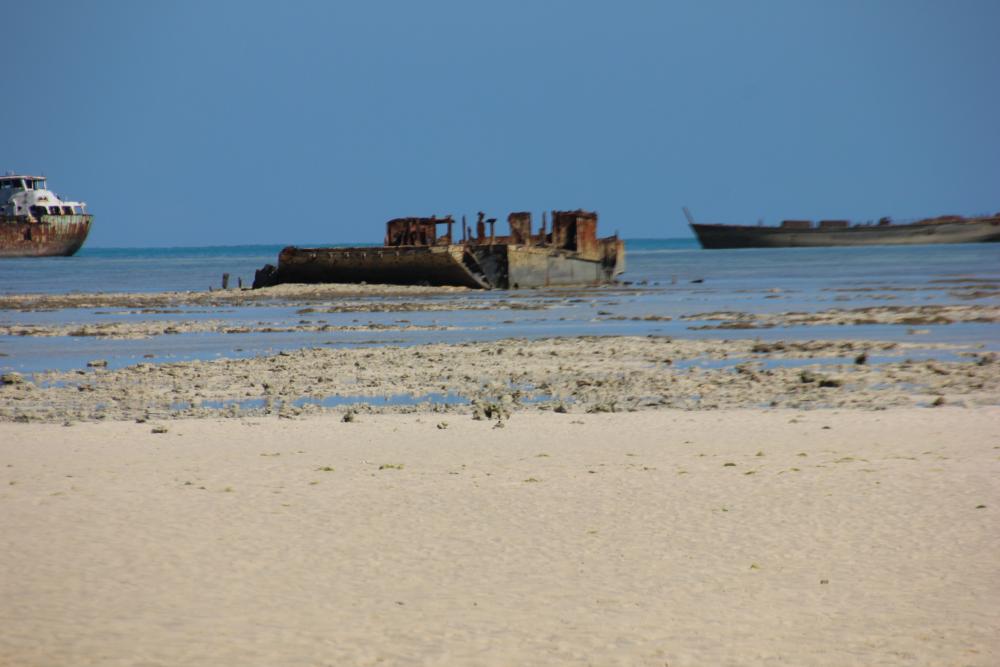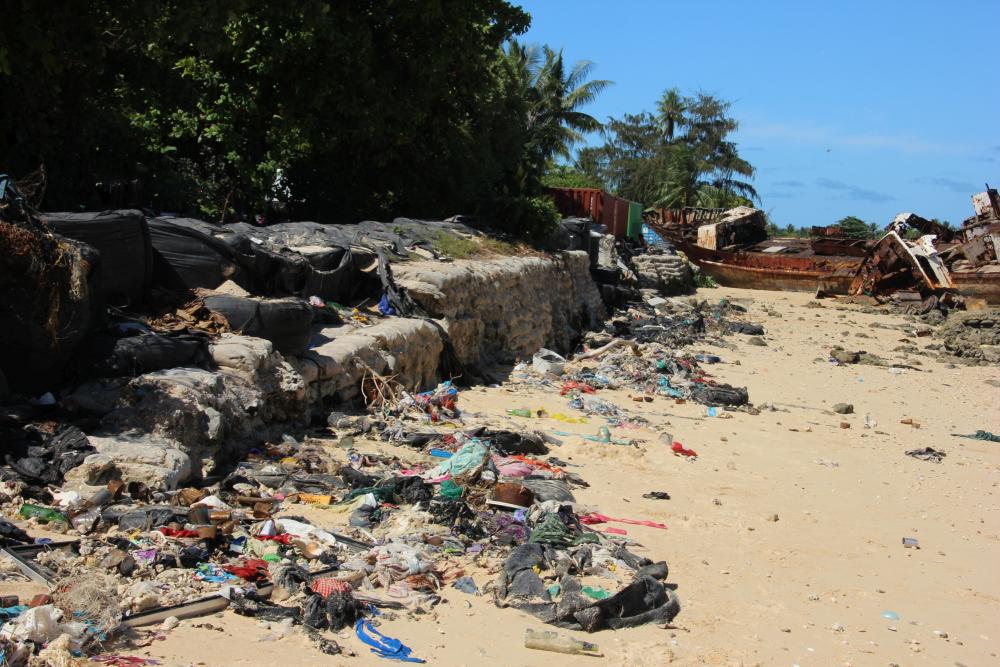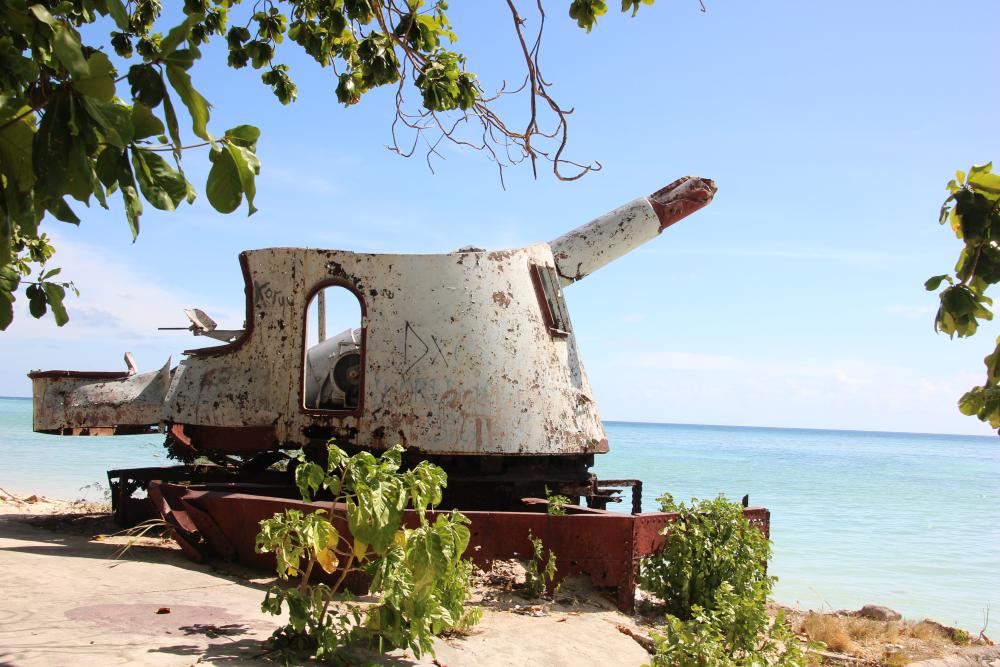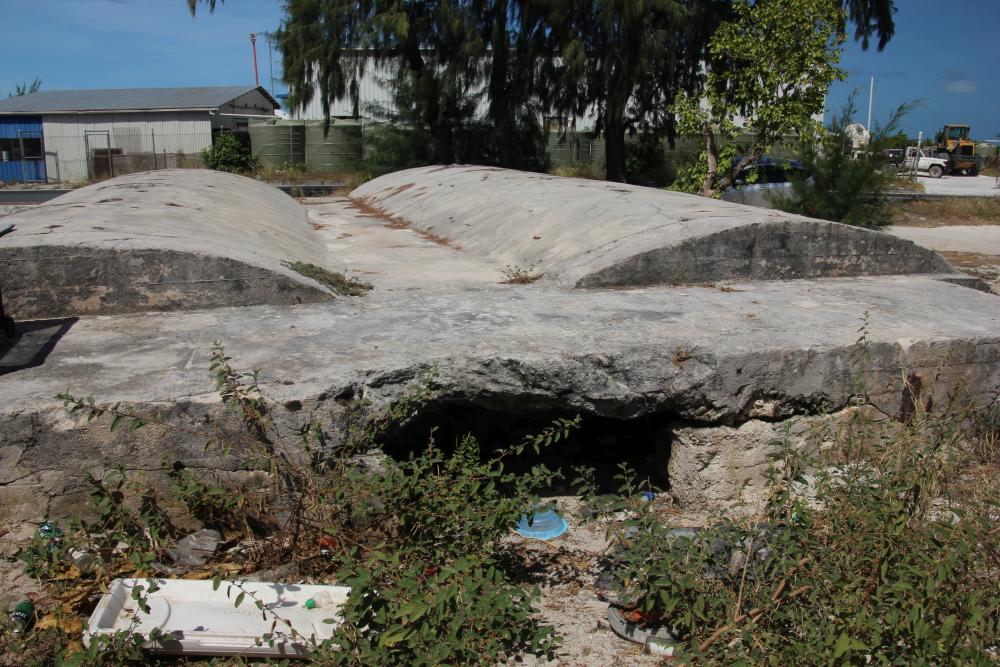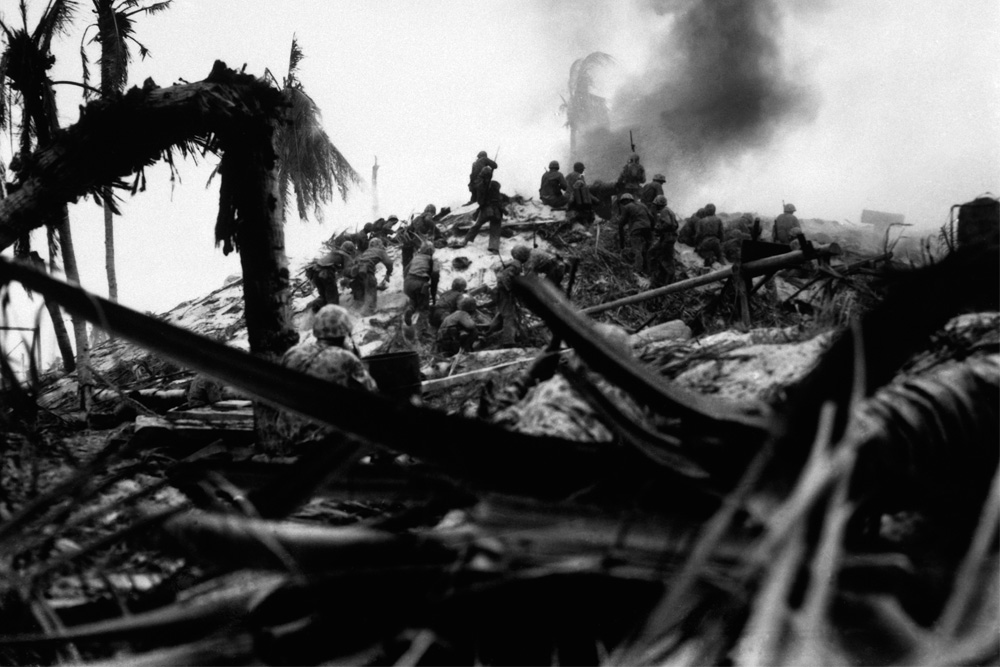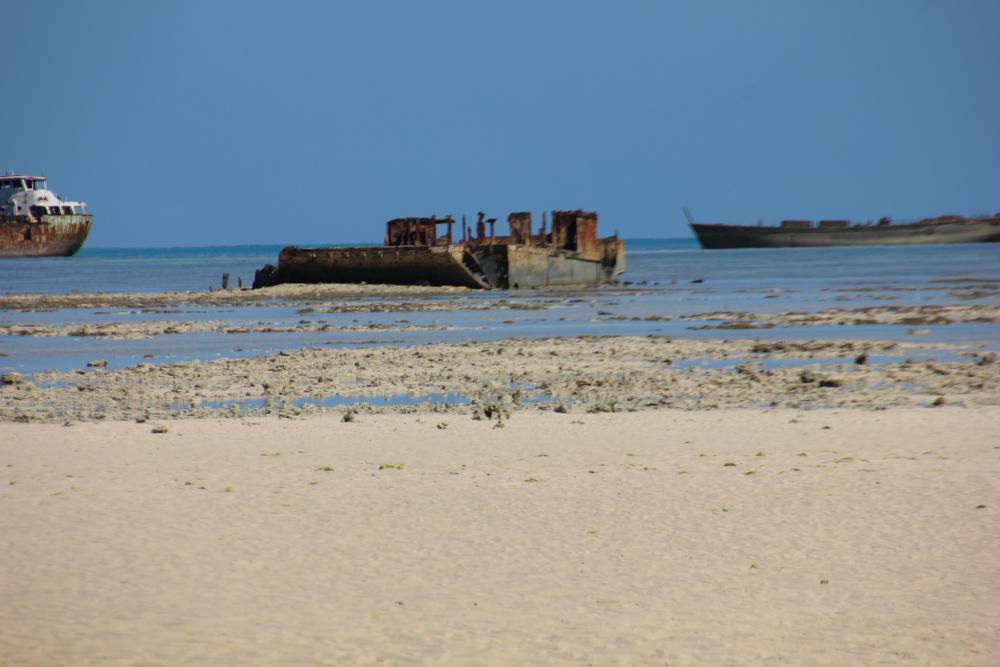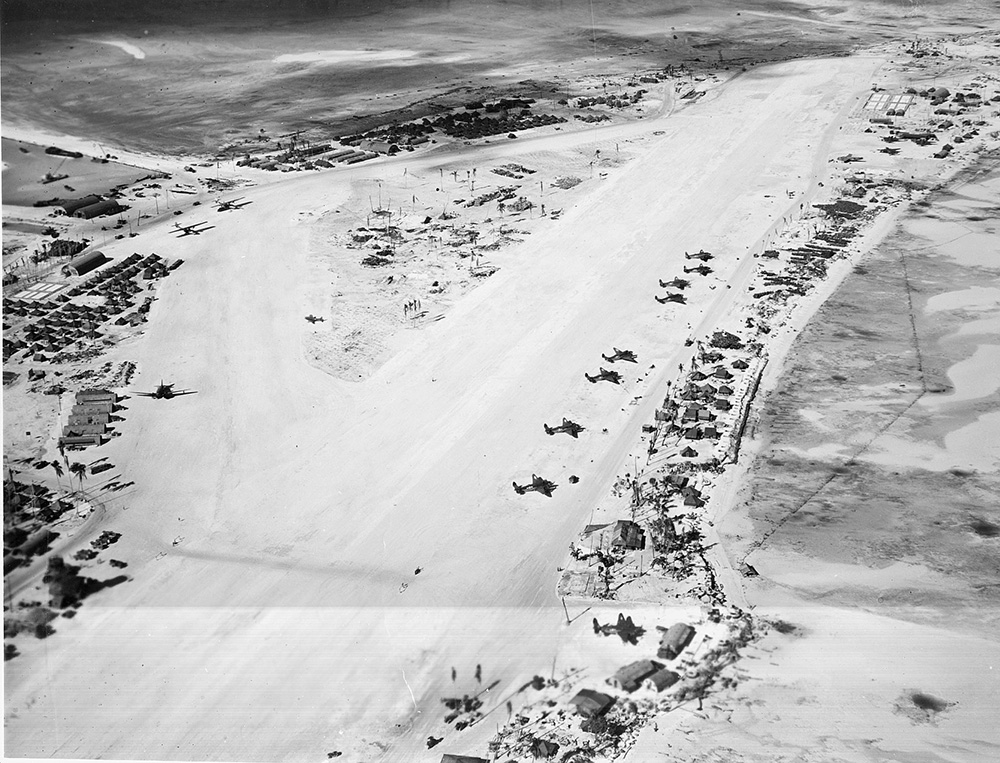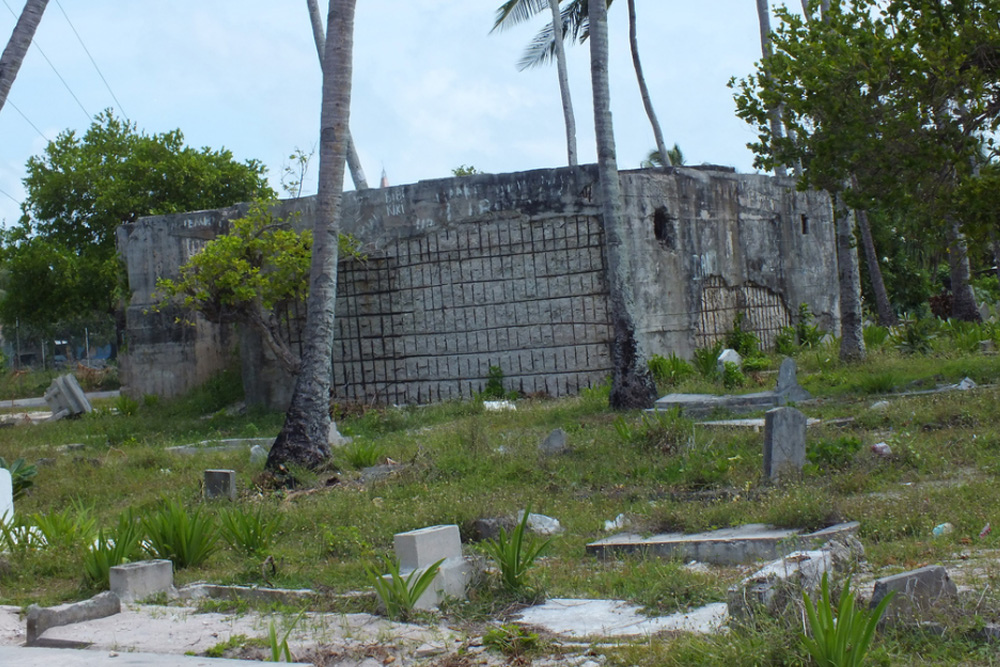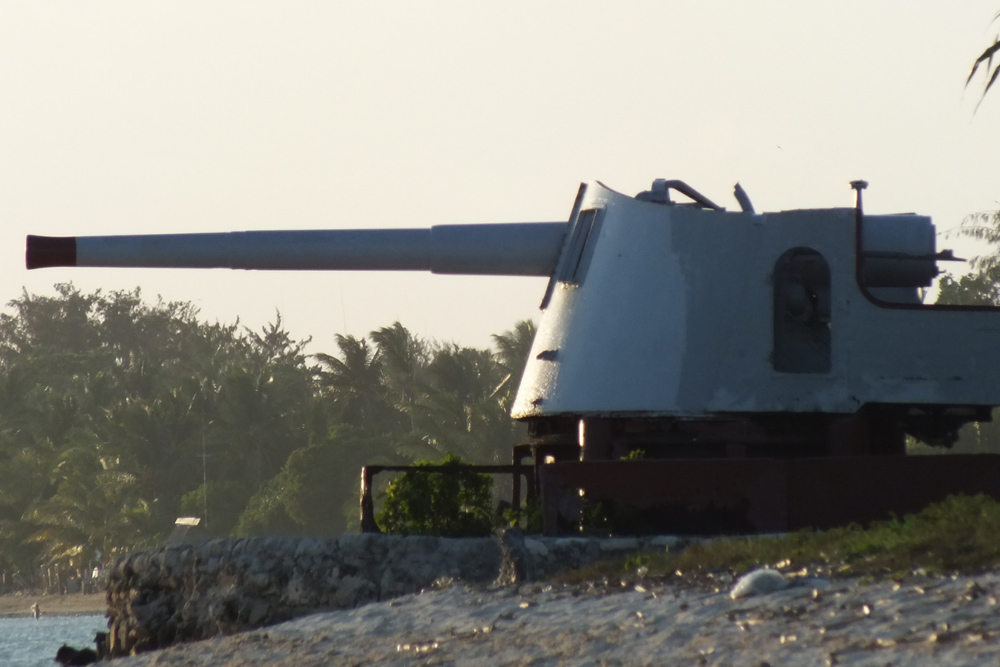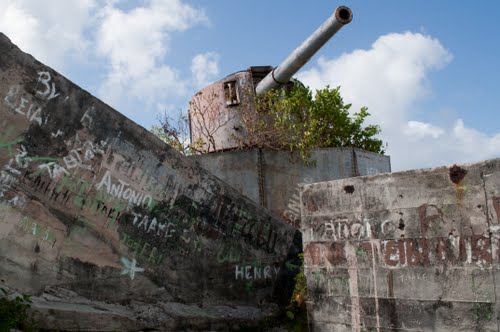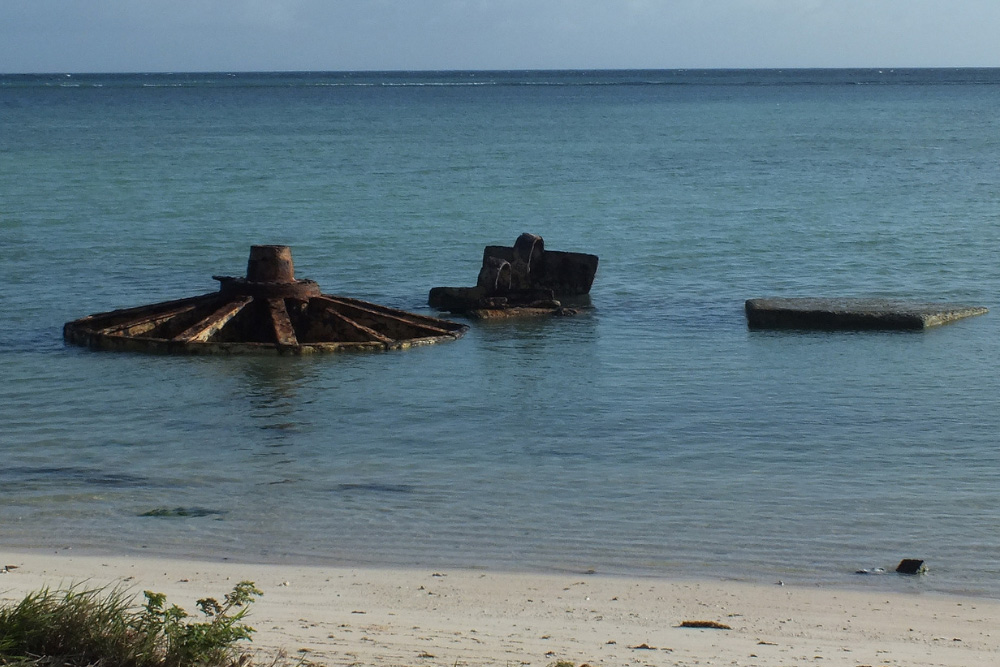Prelude to the Attack
Christened ‘Operation Galvanic’, driving the Japanese out of Tarawa was America’s first step towards the invasion of Japan. It was also the first time Marine Corps amphibious doctrine would be used against a heavily-defended beach.
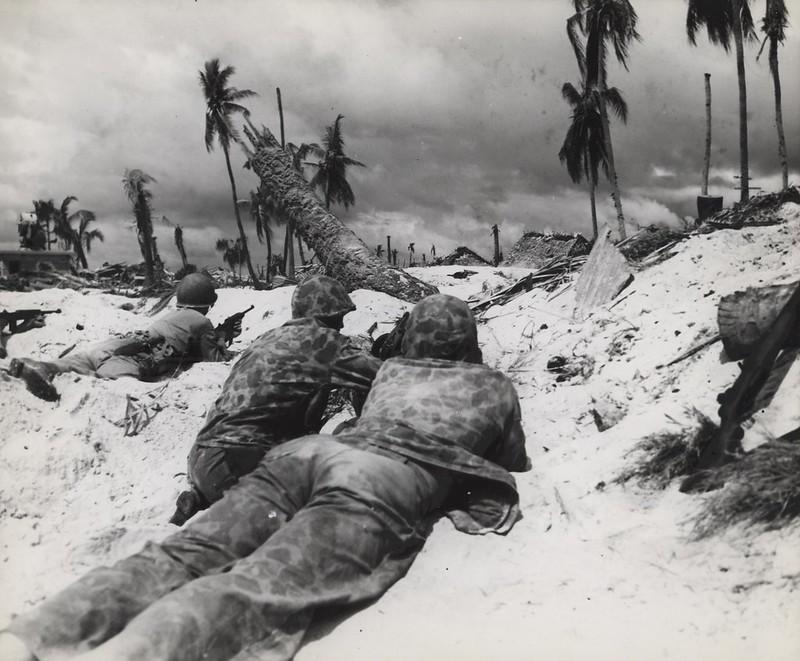
US Marines on Tarawa beach seek cover for Japanese pill boxes. Source: Julian C. Smith Collection (COLL/202), Marine Corps Archives & Special Collections
While the Marines thought their amphibious doctrine was solid, the only example of landing against a heavily defended beach had been the 1915 Gallipoli debacle; British, Australian, and New Zealand forces never got off the beaches and suffered ten months of heavy losses before being withdrawn. The Marines needed to prove they could successfully attack defended beaches, while the Navy needed to show they had suitable assault ships and could provide sufficient logistical and medical support under combat conditions. Both were necessary for America’s offensive strategy on how to best defeat Japan.
Island-hopping was designed to bring the war to Japan within two years. Tarawa, with its newly-built airfield, was the first island that needed to be taken. From Tarawa the Americans would next attack the Caroline and Marshall Islands while American air and naval power protected the sea lanes to Australia and New Zealand, America’s allies to the southwest. From the Marshalls, the Americans would attack and secure the Mariana Islands, from where the B-29’s would launch their air assault on Japan. Taking Tarawa was therefore important tactically, strategically, and nationally.
In comparison, the Japanese plan for defending their newly-conquered island empire was simple; as their ground forces battled the Americans, their bombers would attack the transport/supply ships as the Imperial Japanese Navy (IJN) steamed quickly to engage the American warships. Betio was only a three-day sailing from the huge IJN base at Truk Lagoon, so their defensive plan appeared the best way to bloody the Americans their military still considered ‘soft’.
In the months following their losing Guadalcanal to the Marines, the IJN began to strengthen Betio’s defenses. Commanded by Rear Admiral Keiji Shibasaki, 2,619 Special Navy Landing Forces (Rikusentai) and 2,217 Japanese and Korean Construction Battalions built a series of professionally-engineered concrete, steel, and coconut log bunkers covered with sand. The young Marine infantrymen would face 80mm – 8-inch artillery, Type 88 and 89 (75mm, 127mm) dual purpose anti-aircraft guns, plus the entire range of Japanese Army machine guns and rifles. By the time the Marines arrived, Shibasaki’s men had built some 500 pillboxes, bunkers, and gun emplacements; huge firepower to defend 300 flat, mostly barren acres.
Despite their losses at Midway, the IJN still thought itself capable of defeating the Americans and retaining control of the sea. To bolster morale – and buy the three days the IJN promised as response time, Shibasaki told his men that “a million Americans could not conquer Betio in one hundred years.” But not only had Shibasaki’s Special Navy Landing forces never fought against Marines; unknown to Shibasaki, Admiral William Halsey launched an air attack against the IJN only two weeks prior that not only damaged eight warships, but also destroyed 121 of the IJN’s 173 aircraft.
The IJN would not be coming to Shibasaki’s rescue; the Japanese forces on Betio would live or die based on their own fighting spirit – and soon they would be facing the 2nd Marine Division, led by Major General Julian Smith, who brought their own relentless fighting spirit with them.
20 November, D-Day
Operating under radio silence, the American fleet arrived Betio’s shores undetected, very early morning, 20 November. Only when noise of the assault transport motors reached Betio, did the Japanese react; firing a red flare at 0441, and at 0507 began firing their 8-inch shore guns at the American ship – with every shot missing. Battleships Maryland (BB 46) and Colorado (BB 45), however, had far better results, destroying all four Japanese 8-inch guns and causing the catastrophic detonation of one of the two Japanese magazines.

Japanese 8-inch Vickers naval guns taken out by the Americans. Source: Library of the Marine Corps / Public domain
The assault was confused and slow. The Navy had put the Marines on different ships than their landing crafts, cross-decking took far longer than expected. But finally the tracked landing craft (LVT’s) began moving to the beaches.
Then Navy twice delayed the attack, plus ordered the warships to stop firing, in order for Navy planes to bomb and strafe the Japanese defenses. But with the planes arriving late, Shibasaki used the pause to order his soldiers to rush every wheeled and/or mobile weapon possible from the un-attacked southern beaches to the north shore beaches. Both were watching silently as the LVT’s crawled up onto the shallow coral reef some 600 metres off the beach, gunned their engines to continue their approach over the coral – and the battle was joined as they together opened fire.
Three waves of LVT’s delivered Marines to Red Beach 3, Red 2, and Red 1 into the withering fire of the Japanese anti-aircraft guns and Nambu machine guns, while the LVT’s fought back with their bow-mounted .50 cal. machine guns. Destroyers USS Ringgold and USS Dashell stood only a few hundred metres offshore; raking the island their 5-inch guns on autofire. At 09:10 the LVT’s began to land, and armed with rifles, hand grenades, and flamethrowers, Marines jumped out and began to attack the Japanese defenders on the beaches and under a steel pier that jutted 600 metres out into the lagoon.
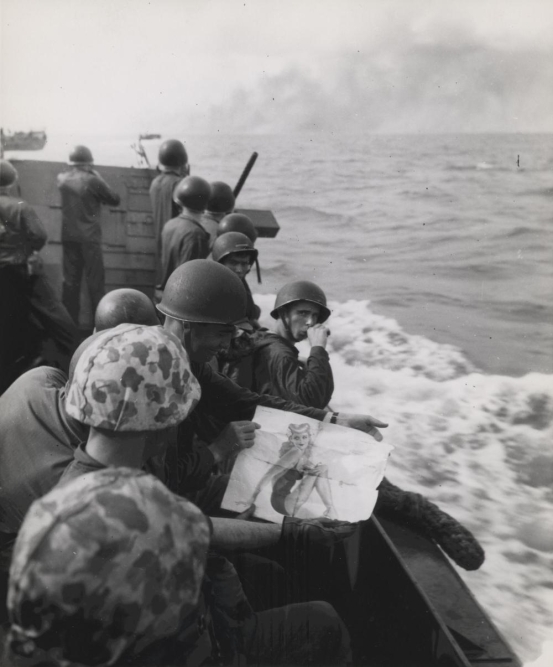
While approaching Tarawa in their landing barge Marines look at a drawing of a Pin-Up-girl. Source: Library of the Marine Corps / Public domain
Eighty-seven LVT’s, in three waves, quickly delivered some 1,500 Marines to the beach. only eight LVT’s had been destroyed. It was a brutal fight, as expected, but the Marines quickly carved-out several tenuous footholds from the beach to approximately 20-100 metres inland. The LTV’s were returning to the edge of the coral reef to shuttle-in more Marines, but then the fog of war… LVT’s began to run out of fuel, or were filled with wounded and went directly to the transport ship still further offshore, or were hit by Japanese fire and disabled/sunk.
As the LVT ‘shuttle plan’ collapsed, the on-coming Higgins Boats with the next waves of Marines began to arrive at the edge of the coral reef. Those Marines were needed ashore; although some 1,500 Marines were now on the island, they were spread in uneven bunches over a mile of shattered beachwall, and dangerously outnumbered by the 5,000 defenders. Marine dead-wounded was unknown, and those still fighting on the beach needed resupply and reinforcing.
The Higgins boats were hung up on the coral because an abnormally weak ‘neap tide’ that rose only some 18inch instead of the usual 36-48inch; while the steel-tracked LVT’s could crawl up and over the reef, the flat-bottomed plywood Higgins boats could not. But the Marines – the majority 17-19 years old and in their first combat, but knowing they were needed ashore – ignored the landing crafts exploding and incoming heavy fire around them and began wading 500-800 increasingly bloody metres to the beach.
Holding their rifles over their heads to keep them dry, the Marines began their slog to shore as Type 88 and 89 antiaircraft guns devastated their ranks. Marines on fire were blown out of their boats to die in the shallow lagoon; others fell wounded into shell holes and drowned. Others were riddled as they tried to walk to the beach, and there were many instances of wounded Marines dragging more-badly wounded Marines ashore. Japanese machine gunners feasted on the knots of Marines struggling through the water, and the lagoon was soon spotted with swirling pools of blood and torn bodies.
A strong cross-tide in the lagoon made matters worse; Marines ashore had no idea where were their officers or if their officers had survived. The devastating Japanese fire had wiped out entire squads, so Marines fought as individuals until grabbed by an officer or senior enlisted to form an ad-hoc fireteam – or individually jumped the seawall and attacked the nearest pillbox.
The carefully choreographed Marine assault had seemingly come apart in the never-ending hail of Japanese fire: Col David Shoup, the 2nd Marine Division commanding officer, was wounded wading ashore, setting up his command post in a just-captured Japanese bunker next to the pier. He had no communication with General Smith on the Maryland, and only limited with battalion commander Maj John Schottel (3rd Bn/2nd Marines) whose Higgins boat was stuck on the reef, while Schoettel was unaware his Executive Officer, Major Mike Ryan, had taken his Marines on a western loop to avoid the carnage and landed on lightly defended Green Beach. Maj Henry Crowe led 2nd Bn/8th Marines onto Red-3, which was east of the pier and suffered heavy losses. The C.O of 2nd Bn/2nd Marines had been killed as he leapt into the water, so Shoup assigned command to an observing officer of the just-formed 4th Marine Division, LtCol Walter Jordan. Shoup was reduced to using runners to learn where Marines had landed and who was in command; it was a bar fight with heavy weapons.
The Navy’s first amphibious ship, the USS Ashland, sailed into the lagoon, as part of the fifth wave. Carrying fourteen Sherman tanks, she flooded her well decks and dropped her ramps, enabling the Sherman’s to land on the coral reef and move ashore. However most of the fording kits that included waterproofing and vertical exhaust kits, had been left behind, so when five Shermans fell into shell holes, their drivers drowned. While six more were destroyed in combat, the surviving tanks proved instrumental in the final victory.
Marines fought as small groups of 2-3-5, whose sole mission was to destroy the bunker ahead before the Japanese in the bunker killed them. Using hand grenades and flamethrowers against the Japanese machine guns, the Marines would destroy a bunker and then move to the next. An embedded combat artist and WW1 Army veteran of Chateau Thierry and Ste Mihel, Kerr Eby said afterwards, “it was a time of utmost savagery.”
Also hung up on the reef were the Higgins boats carrying 1stBn/10th Marine artillerymen, and the howitzers needed to blast the bunkers. When finally in contact, Shoup ordered them to land their 75mm pack howitzers west of the pier. They did; but had to disassemble each howitzer into its seven components and carry each ashore individually. In the following 18 hours the artillerymen carried three batteries of 75mm howitzers ashore, plus shells, and the sun rose on the second day, a battery of 75’s was firing at the Japanese bunkers.
Unknown to Smith, Shoup, or any of the battalion commanders, was that Admiral Keiji Shibasaki had been killed that afternoon. A Marine-Navy Forward Observer team had seen a large group of Japanese soldiers outside a bunker and called a fire mission into Ringgold and Dashell; the two warships were still providing near-constant close-in 5inch naval gunfire. Fused for tree-top height, their salvos caught Shibasaki and his entire staff outside as they were evacuating their headquarters bunker, killing all. Since the heavy American pre-invasion bombardment had already destroyed the Japanese communications grid, the junior officers and senior-enlisted didn’t know they were leaderless and took no initiative of their own until two nights later, when their battle was already lost.
As the sun set over Betio that first night, the Marines, from Gen Smith to the PFC’s, were worried. Although 5,000 Marines were ashore, estimated casualties were 1,500 KIA/WIA, and the Japanese proficiency in night-fighting was well-known. The exhausted Marines were very relieved when the first night passed quietly.
21 November, D+1
The tide remained abnormally low during the second day, which began badly for the Marines. 1st Bn/8th Marines had been a ‘floating reserve’ for the past 20 hours, and now they were needed ashore. Shoup tried to have them approach the island while hugging the pier, but that message was never received.
The second days was a recap of Day 1; the 1st Bn/8th Marines were slaughtered as they waded ashore at Red-2; taking fire from the Type 87/89 anti-aircraft guns firing horizontally into them from three sides, plus the machine guns not yet destroyed.
But to the west, on Green Beach and outside of the maelstrom, Maj Ryan gathered his and other unitless Marines, two surviving Sherman tanks, and another of the Marine-Navy fire teams, and attacked south. By 1100 they controlled the entire length of Green Beach, and using a Marine who knew semaphore, signaled the Navy that Green Beach was secure to land reinforcements. Gen Smith quickly ordered his lone reserve battalion to land. Using rubber boats to avoid the floating Japanese mines, soon 1st Bn/6th Marines, and its full complement of men, weaponry, was landed and headed into the fight.
There were no more Marines to send; those now on the beach would win or die. However Shoup was optimistic, and in that night’s report wrote “Casualties many, percentage dead unknown, combat efficiency: we are winning.”
22 November, D+2
The morning high tide was normal; 48inch instead of the 18inch of the past two days. The Higgins boats, loaded with more tank and self-propelled guns, landed without opposition. The Marines were attacking, flaming, and destroying each bunker, and the Japanese were beginning to commit suicide instead of surrendering. 1/6 Marines led a tank-Marine attack west-east the length of the runway, while Maj Crowe and 8th Marines overwhelmed and destroyed a large bunker in an action resulting in 1st Lt Alexander Bonneyman being awarded a posthumous Medal of Honor.
But surrender the Japanese did not; that night there was a banzaii attack. Both uninjured and injured Rikusentai attacked 1/6 Marines ferociously, with much of the fighting hand-to-hand. Marine artillery and Navy destroyers fired relentlessly while 1/6 held it’s ground against the screaming hordes.
23 November, D+3
Sunrise revealed a grisly battlefield of both Japanese body parts and Marines-Rikusentai locked together in violent death. The Marines had unchallenged control of the island, and the few surviving Japanese committed suicide. Finally, 76 hours after the battle began, Tarawa belonged to the Marines.
Afterwards
The casualty count was horrific. Marine dead (who still today, Nov 2025 are being found), totaled 1,091. Of 2,571 Rikusentai none surrendered. Only eight were captured, and those only due to being found unconscious.
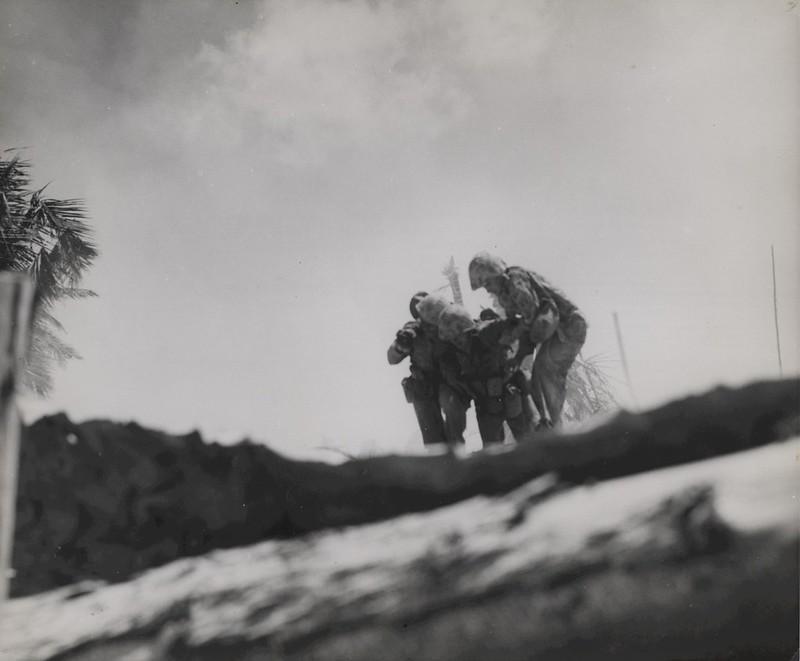
While under fire from the Japanese, two Marines bring a wounded comrade to safety. Source: Library of the Marine Corps / Public domain
An additional casualty count came from the 644 sailors killed when their escort carrier Liscombe Bay was torpedoed and sunk by the Japanese submarine I-175 off nearby Makin Island; it seems the IJN strategy might have worked, had they not underestimated America’s industrial ability to so quickly build the world’s most powerful navy.
They also underestimated the Marine fighting spirit. A few weeks afterwards, one of the eight surviving Rikusentai was asked “Did you ever lose heart?” He replied: “Yes, when the dying Marines still kept coming.”
The Marine Corps and the Media
If you were accredited media, you were welcome to embed with the Marine Corps, a practice that continues to this day. But embedding with the Marines was all-or-nothing: you sailed on the same crowded, hot troopship, you ate what they ate, you waded ashore with them while under fire, and hopefully a corpsman found you quickly if you were wounded. That’s having ‘access,’ as the term is used today. But similar to the wars in Iraq and Afghanistan, embedding with the Marines was a badge of honor, and several of the accompanying media ignored the dangers and stood out:
Hearst Newspaper’s combat artist Gil Bundy was the only survivor on a Higgins boat that took a direct hit from a Japanese shore gun; Bundy, on a smoking hulk and buried under the corpses of four dead Marines, drifted all night in the lagoon until it reached the shore and he was rescued. He continued to draw through the remainder of the battle.
Time Magazine Editor Robert Sherrod came ashore with the fourth wave of Marines, wading in water up to his neck, “I was scared, as I have never been scared before, with machine gun bullets hissing into the water inches to the left and inches to the right.” He lived, and his recollections of the battle, A Story of a Battle became a best-seller in 1944.
AP photographer Frankie Filan quickly pushed his journalistic impartiality overboard. Ruining his two cameras while helping a wounded Marine out of that awful lagoon, Filan continued to rescue other wounded Marines from the water, earning a Navy Commendation Medal for his efforts. Filan then borrowed a camara from a Coast Guard photographer, and won a 1944 Pulitzer Prize for a photograph he took.

The Pulitzer Prize photo by AP photographer Frankie Filan of a decommissioned Japanese bunker. Source: Frank Filan / Public domain
Combat Artist Kerr Eby was 53; the oldest man, American or Japanese, in the fight. His sketchings captured the desperation at the seawall and vicious fighting afterwards. An Army soldier in WW1, Eby fought alongside the U.S. Marines at Chateau Thierry and Saint-Mihiel. When asked afterwards by the young Marines to compare Tarawa with his WW1 combat time, he told them Tarawa was easily the worst, calling it “a time of utmost savagery.”
Marine Combat Correspondent Staff Sergeant Norman Hatch carried a 35mm Eyemo video camera. His landing craft reached the beach, so his Eyemo and extra film cassettes remained dry and usable. When the 2nd Bn/8th Marines Executive Officer ‘suggested’ that Hatch follow him and film them assaulting a Japanese bunker, Hatch did – and returned with the only footage from WW2 of both sides fighting each other while in the same sequence. Following the battle, Hatch helped write and produce the documentary With the Marines at Tarawa that won the 1944 Short-Subject Documentary. Years later Hatch related how President Franklin Roosevelt called journalist Robert Sherrod, and asked if he thought the film might scare the public? Hatch went on to say that Sherrod replied “no, the American public needed to see the truth about what was really going on,” and Roosevelt ordered the film released.
Tarawa Today
While the beaches have long been washed clean of blood after those horrific three days, Betio today is poor and extremely crowded. From the 1,600-ish inhabitants of 1947, the Asian Development Bank estimates some 30,000 people today live on the tiny island. Due to a combination of both Tarawa’s family dynamics and economics; family members living meanly in the very poor outer islands come to Betio to visit, and then stay to scratch-out a living on moderately-poor Betio.
The minimum wage is Aus$ 1.50/hr, while pensioners receive Aus$ 200/monthly from the government. Rice is subsidized, and medical care is free. There are a few wealthy families, but no middle class, as we in the West would expect to see. Off the record, the NGO’s will admit that most people are very poor and will remain that way.
Job opportunities are virtually non-existent. There is only one copra-processing facility that employs 20-ish when it operates. No phosphates or other deposits whose mining or processing would create steady jobs. Betio is so small only one main street (the old Japanese airfield) runs through it. On both sides of the two-lane road are dozens of little shops selling water, sodas, small bags of crisps, health sundry’s and some canned foods; while snaky little dirt trails lead to shabby housing made from twisted galvanized sheets and cardboard. Only breadfruit and coconuts grow here, and the only farm animals are chickens and pigs. Virtually everything of value or eaten is imported.
Money is scarce, which makes growing an economy virtually impossible. The Australian Dollar is the official currency, but the airport does not have a currency exchange; anyone visiting needs to change money at the departing airport. There is a single ANZ branch on Betio, but they only exchange currency for those with an existing account. ANZ advertises their seven ATM’s, but too often they are inoperable due to power failures, computer failures, or simply out of cash.
An Australian-funded vocational school teaches basic auto mechanics, basic IT, fundamentals of teaching, and Senior Care. Funding for it, a myriad of K-12 schools, a desalinization plant, and a hospital comes from Australian and New Zealand government aid, the Asian Development and the World Bank. Many young men and women leave for agricultural jobs or Elder Care posts in Australia and New Zealand and send money home; one wonders how many ever return.
The government’s largest foreign exchange earner is the sale of fishing rights to Japanese, Korean, and Chinese commercial fishing companies, whose motherships can be seen moored offshore while their trawlers are catching dozens of thousands of tons of fish for foreign markets. Fish caught locally are best uneaten as the rudimentary sanitation service pumps sewage directly into the lagoon, and the views of the stunningly beautiful beaches are often marred by the views of children poo-ing and wee-ing off the rocks and into the waters.
This is a tragedy. The Gilbertise are a proud and lovely people, and an integral part of Marine Corps history and tradition was hard-earned here. Surely the World Bank, NGO’s, and various governments could have done better since WW2 ended in 1945.
Unlike the immaculate WW2 battlefields maintained in Europe by the American, British, French, and Dutch governments, there are only two small monuments to the Marines on Betio. Tourists can walk to the two Japanese shore artillery pieces pointing south, and at low tide one can wade to a US Marine Sherman tank that foundered 50 meters off Red-2, plus two LTV’s (recognizable by the drive wheels and tracks), and several very rusted frames of other landing craft.
Old Japanese defensive bunkers are easily found; however for decades they were used as impromptu toilet-less bathrooms. The Bonneyman Bunker, named after the bunker where 1st Lieutenant Alexander Bonneyman earned his posthumous Medal of Honor in capturing it, is out of sight behind a police station. When asked, the police on duty will gladly show you the bunker – however it is full of corroded but possibly live ammunition, and the interior is securely locked with entry forbidden.
The comparison between Betio and the immaculate American and British cemeteries of Omaha Beach, Bayeaux, and other locales is jarring. The European battlefields seem to belong to a different war and a different time period, in contrast to the filth-strewn bunkers and rusting shore guns the few visitors with family or Marine Corps links to Tarawa see today. While the beaches are now clear of the debris piles so evident in the photos of the 1960’s-1970’s, it is likely that demographic congestion, geopolitics, and overpopulation will soon overwhelm both Betio and this incredible chapter of Marine Corps history.
Information
- Article by:
- Andrew Lubin
- Published on:
- 06-12-2024
- Feedback?
- Send it!
Related sights
Related books
Sources
- ALEXANDER, JOSEPH H. (COL), Utmost Savagery, Naval Institute Press, Annapolis, 2008.
- LECKIE, ROBERT, Strong Men Armed, Random House, New York, 1962.
- MANCHESTER, WILLIAM, Goodbye, Darkness, Little Brown, Boston, 1980.
- SHERROD, ROBERT, Tarawa: The Story of a Battle, Duell, Sloan and Pearce, New York, 1944.
Naval History Magazine, US Naval Institute, Dec 2008
- ‘A Bloody Proving Ground’, Col Joe Alexander, p. 10-17.
- ‘Across the Reef’, Col Joe Alexander, p. 18-27.
- ‘An Enduring Legacy’, Col Joe Alexander, p. 28-35.
- ‘What War was Like/ , Interview w/Maj Norman Hatch, p. 37-40.
Other publications
- World War 11 (Primedia), The Pacific War, Collectors Edition, 2003 ‘Tarawa's Grim Toll’, V. Keith Fleming, Jr, p. 34-40.
Personal Interviews with Author
- Maj John Turner Jr, USMC (ret); Nov 2024, Betio Lodge 1, Betio; Tarawa. Maj Turner's father served in 1/10 Marines, and he told me about his dad disassembling the howitzers and carrying the pieces and shells ashore.
- Master Gunnery Sgt Michael Santivasi, USMC (ret), served in 1/10 Marines in Task Force Tarawa (March 2003) and in phone interview told me of how USMC used the 1943 fight to motivate their Marines with the spirit of the 1/10 Marines who fought at Tarawa.
- Sgt Philip Lubin, USMC, who served with Master Guns Santivasci in March 2003'd fight at an-Nasiriyah and confirmed on an enlisted level what Master Guns Santivasci told me.
